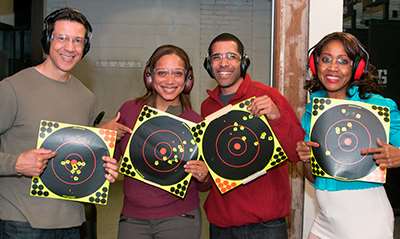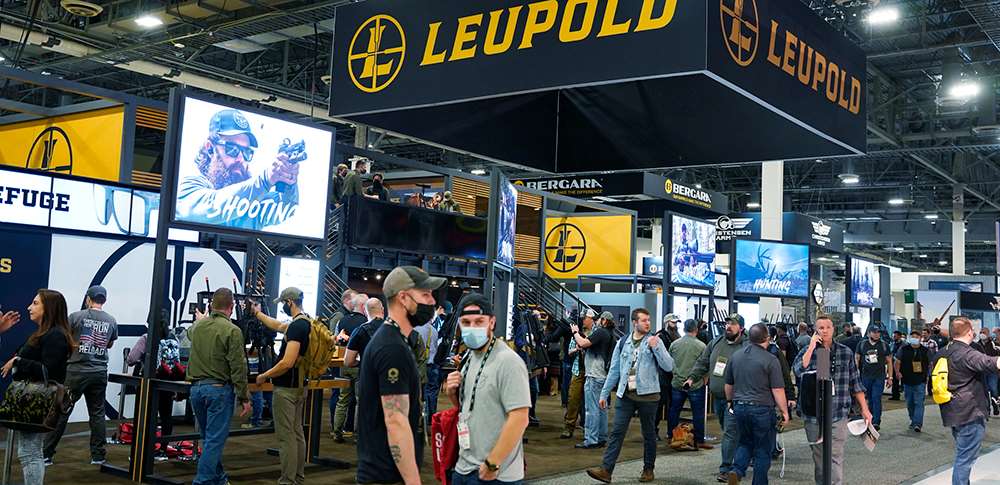
Imagine if you only read The Washington Post and only watched MSNBC and like-minded media outlets. If you did that, you might be deceived into thinking America is a regular Wild West Show of daily mass shootings. You might think guns themselves are evil and that crime is the fault of people who legally own firearms. You might even believe that an American citizen could simply go online and buy a machine gun, as former President Barack Obama (D) once told us. You might also think that suppressors are the tools of assassins, and that semi-automatic rifles with pistol grips are commonly used by criminals. Perhaps you’d even surmise that President Joe Biden (D) was making a good point when he suggested a ban on pistols chambered in 9 mm.
At best, many of these gun-control narratives are simply based on ignorance of firearms. At their worst, a considerable percentage of the mainstream media’s storylines regarding the Second Amendment are outright falsehoods meant to convince people to vote away their freedom.
Every issue of America’s 1st Freedom is filled with sourced facts and honest perspectives designed to arm citizens with the truth, but sometimes these kinds of list articles are needed to refute the shotgun patterns of anti-Second Amendment propaganda coming from the mainstream media and gun-control groups.
1. According to “The Impact of Mass Shootings on Gun Policy,” a working paper published by the Harvard Business School, “mass shootings” accounted for about 0.13% of all deaths with guns and 0.34% of murders in which guns were used between 1989 and 2014. The authors defined a “mass shooting” as involving three or more victims that were not romantically related and used state and federal law-enforcement statistics for their data.
2. Unfortunately, much of the American public does not have a very accurate understanding about deaths resulting from the use of firearms. A 2019 survey conducted by the APM Research organization discovered that, while suicides account for 60% of all gun deaths in the United States, “by and large American adults are unaware of this. In our survey, only one-fourth of Americans correctly answered that gun deaths by suicide outnumber deaths resulting from mass shootings, murders other than mass shootings, and accidental gun discharges.”
So what do Americans think are the leading causes of gun deaths? According to the APM survey, one-third of American adults believe that “murders other than mass shootings” is the top cause of death by firearms, while one-quarter think mass shootings are actually the leading cause of gun-related deaths. Likely, these people are being led into misinformation by the mainstream media.
Gun-free zones are attractive to the few sociopaths who want to harm as many people as they possibly can.
3. While all mass-murder events are of course horrific, here’s something the media won’t tell you: According to data collected by John Lott’s Crime Prevention Research Center, 94% of these murders occur in “gun-free” zones!
This data was collected from murders that occurred from 1950 to 2019; in these, “mass shooting” is defined as an event with four or more victims killed. Gun-free zones generally allow the police to carry firearms in them, but civilians are usually prohibited from doing so. Clearly, “gun-free zones” are attractive to the few sociopaths who want to harm as many people as they possibly can.
4. With the mainstream media’s near-continual focus on guns being used by criminals, you wouldn’t know that one survey estimates that 31.1% of all gun owners have used a firearm to defend themselves or their property, often on more than one occasion. This statistic is based on the 2021 National Firearms Survey, with the results published by William English of the McDonough School of Business at Georgetown University.
This paper further said, “Handguns are the most common firearm employed for self-defense (used in 65.9% of defensive incidents), and in most defensive incidents (81.9%) no shot was fired. Approximately a quarter (25.2%) of defensive incidents occurred within the gun owner’s home, and approximately half (53.9%) occurred outside their home, but on their property. About one out of ten (9.1%) defensive gun uses occurred in public, and about one out of twenty (4.8%) occurred at work.”
5. Not surprisingly, protection against crime tops the list of reasons why gun owners have firearms. According to a Gallup survey conducted in 2021, 88% of U.S. gun owners surveyed cited protection against crime as the reason they owned a firearm—up from 67% in 2005.

6. The recent COVID-19 pandemic, and the civil unrest that spread across the nation in 2020, appears to have prompted more Americans than ever to buy firearms. As Pew research found: “Federal data suggests that gun sales have risen in recent years, particularly during the pandemic. In 2020, the number of monthly federal background checks for gun purchases was consistently at least 20% higher than in the same month in 2019, according to the FBI’s National Instant Criminal Background Check System. The largest comparative percentage point difference occurred in July 2020, when about 3.6 million background checks were completed, 44% more than were conducted in July 2019.”
7. Despite the continued media drumbeat for ever more gun laws, public support for more gun control has continued to erode. As Larry Keane, vice president and general counsel for the National Shooting Sports Foundation (NSSF), wrote in November 2021: “Two recent polls show the shift. Gallup pins American support for more gun control at a tick above 50%, the lowest mark since 2014. At the same time, Quinnipiac polling pegged the number even lower, showing just 45% support stricter gun laws—a drop of nine points since April this year. Included in the data is that 54% of self-described Independents oppose enacting more gun laws.”
8. Another media myth is that it’s only white men who exercise their Second Amendment rights. That’s never been true—the recent surge in firearms purchases reinforces the fact that all Americans, regardless of race, rely on the Second Amendment. According to the NSSF’s firearm-industry survey data, more than 8.4 million people bought their first gun in 2020 and at least 5.4 million people purchased a firearm for the first time in 2021. “That also reflected hikes in African-American, Hispanic-American and Asian-American gun buyers. More than 3.2 million Americans bought their first firearm within the first six months of 2021,” reported the NSSF.
9. When campaigning for the presidency in 2019, Joe Biden told a New York audience, “If I get elected president of the United States of America with your help, if that happens, guns, we have the capacity now in a James Bond-style to make sure no one can pull a trigger unless their DNA and fingerprint is on it,” Biden said. “We have that capacity to do it now. You know it.”
President Biden might like the potential for government control that such a technology could theoretically create for a gun-control-loving politician, but, as this was being written, no reliable so-called “smart gun” had been introduced; though there had been recent reports that some have continued to invest in researching and developing these products, a gun that can reliably read fingerprints or DNA is likely decades away.
Also, the NRA is not opposed to these products being made available, if they prove to be safe and reliable; what the NRA is opposed to is these products being made mandatory (such as a politician, like Biden, using a “smart-gun” mandate as a way to ban the many reliable firearms now available in the American marketplace.)

10. With ever-more regulations being proposed for firearms retailers and gun shows—usually proposed as a way to fight “gun violence”—those who only read or watch the mainstream-media outlets might think that a large percentage of violent criminals get their firearms via these legal sources. But the opposite is true.
According to data gathered by the U.S. Department of Justice (DOJ), Office of Justice Programs, Bureau of Justice Statistics, a 2016 survey of prison inmates found that: “Fewer than 1 in 50 (less than 2%) of all prisoners had obtained a firearm from a retail source and possessed, carried or used it during the offense for which they were imprisoned.” Over half these criminals stole their firearms, while 43% bought their guns through illegal means.
Gun-control advocates continually try to enact more-restrictive regulations on gun shows while suggesting the shows are magnets for criminals in search of guns. Untrue! As the above-cited DOJ research found, “Among prisoners who possessed a firearm during their offense, 0.8% obtained it at a gun show.”
11. Despite what the mainstream media reports, there is no “Charleston loophole” in federal guns laws. All gun sales through federally licensed gun dealers require background checks, but if the checks are not approved within three business days, the dealer has the option to transfer the firearm to the buyer if they don’t believe the person has attempted to break the law to obtain the firearm.
As NRA-ILA has noted, this three-day provision is not a “loophole.” It is a necessary component of our current background-check system. The three-day provision is a safety valve that ensures that American citizens are not arbitrarily denied their Second Amendment rights. Without the three-day provision, the FBI has no incentive to complete checks in a timely manner.
Not surprisingly, protection against crime tops the list of reasons why gun owners have firearms. According to a Gallup survey conducted in 2021, 88% of U.S. gun owners surveyed cited protection against crime as the reason they owned a firearm—up from 67% in 2005.

12. Waiting periods for the transfer of firearms appear to have little to no impact on crimes where firearms are used. That’s contrary to the narrative that insists that longer and longer periods before transfers can be completed will reduce violent crime. As the Bureau of Alcohol, Tobacco, Firearms and Explosives (ATF) reported, the average time between when a firearm was sold at retail and when it was confiscated at a crime scene in the U.S. in 2020 was 7.01 years!
13. You can’t “buy” a gun online and have it shipped to your home. Yes, there are websites where firearms are sold, either at a fixed price or in a bidding process. But once the firearms are sold, unless the seller and purchaser reside in the same state, and the state does not require a background check for firearm transfers between private citizens, they must be sent to a federal firearms license (FFL) holder in the state in which the purchaser resides. The FFL receives the firearm and then requires the purchaser to undergo the required federal background check before the firearm can be transferred to said customer. Even when the seller and purchaser reside in the same state, and that state does not require a background check for private transfers, the firearm cannot legally be shipped to complete the transfer. The transfer must be done face to face.
14. Gun-control advocates often attack people who choose to carry concealed firearms for personal protection, arguing that “more guns on the streets equals more crime.” But, in fact, concealed-carry permit holders are much less likely to commit crimes than average people—or even police officers. According to data compiled by the Crime Prevention Research Center (CPRC): “Concealed handgun permit holders are extremely law-abiding. In Florida and Texas, permit holders are convicted of firearms-related violations at one-twelfth of the rate at which police officers are convicted.”
CPRC also looked at concealed-carry revocation rates in 20 states and found that revocation rates are very low; just .009 percent in Arizona, for example.
15. Gun ownership has surged in the last two decades, as has the number of people with concealed-carry permits and the number of states with constitutional-carry laws; meanwhile, prior to 2020’s civil unrest, violent crime had generally been dropping for decades. Of course, there are multiple factors that affect crime rates; the thing is, if the gun-control narratives were correct, these increases in gun ownership and concealed carry would push violence levels up.
As NRA-ILA reported in October 2020: “The violent crime rate has decreased 52% from the 1991 all-time high. Americans have acquired more than 215 million new firearms in the same time period—more than doubling the number of privately owned firearms in the United States. As violent crime has decreased, the number of Right-to-Carry (RTC) states and the number of people who carry guns for protection away from home have risen to all-time highs.”

16. In yet another case where gun-control advocates seem to do their research via Hollywood movies, the vast majority of suppressors (or “silencers”) do not reduce the sound of a gunshot to a “pfft.” Suppressors on firearms generally cut that blast of noise by 20 to 35 decibels, reducing it to levels that are less likely to cause hearing damage.
According to the American Suppressor Association: “Even the most-effective suppressors, on the smallest and quietest calibers (.22 LR) reduce the peak sound level of a gunshot to between 110-120 dB. To put that in perspective, according to the National Institute for Occupational Safety and Health (NIOSH), that is as loud as a jackhammer (110 dB) or an ambulance siren (120 dB). For normal caliber handguns and rifles, suppressed sound levels routinely exceed 130 dB, just shy of [the] ‘hearing safe’ threshold of 140 dB.”
17. Accidents with firearms have been declining for decades. According to the National Safety Council’s Injury Facts: “From 2008 to 2018, unintentional firearm-related fatalities declined by 22.6%.” At the same time, firearm sales grew by an estimated 40%. One big reason for this is how much NRA-certified firearms instructors and NRA programs have done to teach and promote safety.
Facts matter, especially when certain parties use misleading story lines to try to take away our Second Amendment rights. In each issue, we’ll continue to bring you the real facts about our freedom.


































